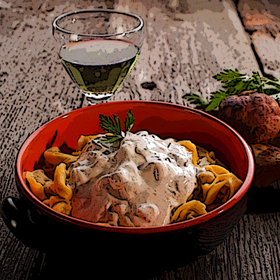The Cumulative Effect In Food And Wine Pairing.
Chapter Nine, Part Six.
 When pairing food with wine the cancellation effect works to your advantage once you understand how to balance the taste or texture of sweet and acidic food with similar traits in wine. While acidity and sweetness cancel each other out when combined on your palate, bitter and piquant sensations accumulate and magnify one another. The same can be said for pairing low acid foods with low acid wines so I’ll go ahead and say it; creamy or fatty traits do not cancel each other out; they accumulate on your palate (and also on your waistline). So after many years of deliberation I’ve decided to call this the cumulative effect.
When pairing food with wine the cancellation effect works to your advantage once you understand how to balance the taste or texture of sweet and acidic food with similar traits in wine. While acidity and sweetness cancel each other out when combined on your palate, bitter and piquant sensations accumulate and magnify one another. The same can be said for pairing low acid foods with low acid wines so I’ll go ahead and say it; creamy or fatty traits do not cancel each other out; they accumulate on your palate (and also on your waistline). So after many years of deliberation I’ve decided to call this the cumulative effect.
Some may argue that matching a rich, creamy-textured dish with a rich, creamy wine is an ideal pairing based on similar textures and flavors, but I find this combination turns the wine flabby and lifeless. Picture a rich, creamy Alfredo sauce, hemorrhaging cheese, cream and butter over your tortellini. Now imagine a low-acid, full-bodied Chardonnay as thick and rich as day-old Greek yogurt. Separately, their viscous textures and satisfying richness may please the palate, but combine the two and the flavors become redundant and the creaminess accumulates on your palate like fossilized butterfat stratum. A pairing like this will require frequent refills of your water glass to wash down your cholesterol meds.
I prefer the attention-grabbing relief generated by contrasting textures. Try a crisp, high-acid wine with your Alfredo dish and note how the different textures keep your palate refreshed. When acidity enters your mouth it assaults your cheeks and gums but this abrasive sensation is alleviated when your mouth is coated with fatty foods. The contrasting elements render the wine smoother and less tart. The pasty combination of creamy food and creamy wine has also been known to leave you feeling bloated. Acidity cuts through cheesy foods and nothing relieves that bloated feeling like cutting the cheese.
Bitterness is one of our basic tastes that is heightened by the cumulative effect. When you combine bitter foods – such as unsweetened chocolate, artichokes, broccoli rabe, endive, freshly ground black pepper, or certain herbs and spices – with a bitter wine, let’s say one that’s excessively high in tannin, the bitterness will only accumulate on your palate like a painful divorce. Have one too many meals with this uncomfortable combination and you and your spouse may soon be arguing over who gets stuck with the Yanni CD’s.
To counter the bitterness of overly tannic wines, pair them with foods high in fat such as ribeye steak. It may only be a matter of time before fat is recognized as a sixth taste alongside sweet, sour, salt, bitter and umami but that’s food for a later post. The contrasting elements make the wine less bitter while reducing the unctuous sensation created by fat.
Another sensation that accumulates on your palate is heat. When piquance, the “hot” sensation found in spicy foods, is combined with wine high in alcohol, the alcohol is accentuated, magnifying its “hot” properties. Initially the wine may have a cooling effect in your mouth, even tasting fruitier and softer, but as the cumulative effect builds the wine can turn as hot and bitter as a recently divorced Kardashian.
One of the common misconceptions I often hear is the belief that a bold red Zinfandel pairs well with hot, spicy foods because Zins are noted for their spicy flavors. Many Zinfandels are also noted for their high alcohol levels making them poor candidates for piquant pairings.
Hot, spicy dishes require a pairing based on contrast, so choose a chilled, fruity, low alcohol wine or a wine with a touch of residual sugar to create some sweet and spicy synergy. Not only will it satiate the palate-devouring effect of piquance, the contrast in temperature can reenergize your palate. You will discover that when the jalapeño sauce is flowing, the cool embrace of a fruity wine keeps your taste buds partying like its 1969. If you’re too young to know what that means, try an off-dry Gewurztraminer with some extra spicy Buffalo wings and then drop some antacid.
• Summary: The cumulative effect occurs when abrasive tastes like bitterness and piquance reinforce and magnify each other on your palate. It also comes into play when low acid food and wine are combined. Consider contrasting flavors and textures to sooth these savage beasts. Fat counters the sharpness of acidity and the bitter bite of tannin, and sweetness alleviates the heat of piquance.




















